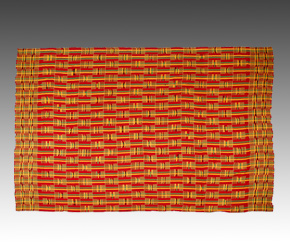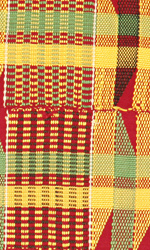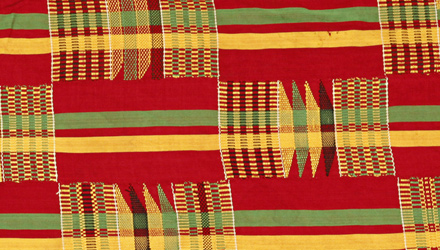Akan Kente Cloth
 |
|
Kente is a woven cloth of cotton and silk that originates from the Akan people of Ghana in West Africa. Although having the appearance of fine tapestry, kente was traditionally woven as thin strips on a loom. These strips were then stitched together to form a toga-like garment. Kente cloth was originally a garment worn only by royalty and high chiefs for special occasions and ritual ceremonies.
 |
|
One such major festival where kente can be seen is the Asae Kese, an important celebration in Ghana to this day. The festival was first held to commemorate the achieving of Asante statehood in the late 17th century and is today a ceremony to pledge allegiance and loyalty to the kingdom. Although much of the rituals are done privately in the presence of the king, the public component of the festival brings together the largest gathering of people wearing kente. During the procession, the king, chiefs and the queen mother are surrounded by musicians, state sword bearers and attendants waving cloths, some of which are kente, to cool the chiefs. On occasion, the chiefs will stand and dance with a sword in one hand and a horsetail flywhisk in the other. Their kente create a billowing tapestry of color complemented by flashes of gold from the chief’s royal jewelry.
Kente is woven into creation with many different colors, each representing a symbolic meaning. Gold, for example, represents royalty, wealth and spiritual purity. Silver symbolizes serenity, purity and joy. Yellow signifies preciousness and fertility. Blue stands for peacefulness, harmony and love. Other colors such as black, green, gray, maroon, pink, purple, red, and white also epitomize various important elements of life, growth and spirituality.
The use of kente cloth is not only limited to clothes. Royal fans are sometimes made of kente, the most renowned made for the queen mother. During festivals, kente are also used to line the palanquins, demonstrating the great size the cloths can be woven to. The Akan people also dress their gods in kente, often by draping shrines with them or by placing holy items on kente covered stools. More recently, kente has been utilized as frames, such as for a backdrop of a portrait or photograph. Across the Atlantic today kente is increasingly being used as accessories such as hats, ties, bags, shoes and jewelry. It can also be spotted at graduations as part of academic robes, and on other occasions as stoles or even liturgical robes.

|
|
Download this Article: Kente Cloth.pdf